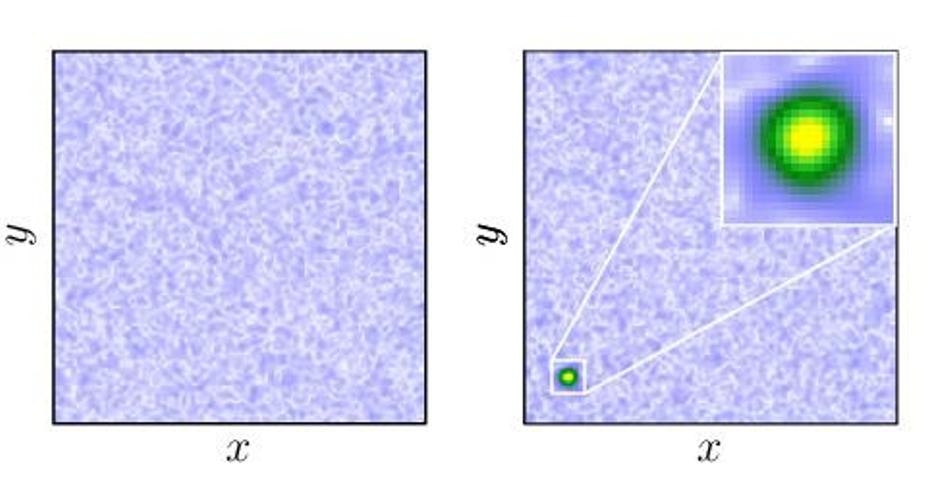Oct 23 2018
A new mathematical model recently developed by researchers describes the motion of dark matter particles present within the smallest galaxy halos.
 Left image: initial moment, when the gas is mixed; right image: the moment shortly after the formation of a Bose star. The color indicates density: white-blue-green-yellow, from sparse to dense. (Image credit: Dmitry Levkov)
Left image: initial moment, when the gas is mixed; right image: the moment shortly after the formation of a Bose star. The color indicates density: white-blue-green-yellow, from sparse to dense. (Image credit: Dmitry Levkov)
The researchers noted that the dark matter may possibly form round droplets of quantum condensate over time.
This was previously believed to be impossible, because variations of the gravity field created by dark matter particles were not taken into consideration. The results of the study have been reported in Physical Review Letters.
Dark matter does not produce electromagnetic radiation. It is this property that prevents searches related to dark matter and even makes it difficult to establish its existence.
Dark matter particles have a low speed and this property makes it easy for galaxies to retain them.
The interaction of these particles with one another as well as with the ordinary matter is so weak that only their gravity field can be perceived, or else the dark matter will not manifest itself in any manner.
A dark matter shell (halo) of much larger mass and size surrounds each galaxy.
The majority of cosmologists assume that dark matter particles have a large mass and therefore have a high speed.
However, earlier in the 1980s, it was discovered that under certain conditions, dark matter particles would have been formed in the early Universe with nearly zero speed, irrespective of their mass. Moreover, these particles could even be very light.
As a result, the distances at which the particles’ quantum nature turns out to be obvious are likely to be huge.
The “quantum” scale for dark matter particles may be similar to the size of the central portion of the galaxy, rather than the nanometer scales that are often needed to view the quantum phenomena in labs.
The team noted that if the dark matter particles are bosons with adequately small mass, they might form a Bose-Einstein condensate in the tiny galaxy halos or in even tinier substructures because of their gravitational interactions.
Such types of substructures contain miniclusters, which are extremely small systems formed sorely by dark matter, and halos of dwarf galaxies, which are systems of many billion stars adhered together by gravitational forces.
The Bose-Einstein condensate is a state of quantum particles, wherein they all dwell in the lowest energy level that has the smallest energy.
It is possible to produce the Bose-Einstein condensate from ordinary atoms within the laboratory at low temperatures. This state of matter shows special properties, for example, superfluidity which is the ability to travel through tiny capillaries or cracks without any friction.
Within the galaxy, light dark matter has huge concentration and low speed. Under these conditions, this dark matter should gradually produce a Bose-Einstein condensate.
However, for this to occur, there must be an interaction between the dark matter particles, while as far as one knows, only gravitational interaction occurs between these particles.
In our work, we simulated motion of a quantum gas of light gravitationally interacting dark matter particles. We started from a virialized state with maximal mixing, which is kind of opposite to the Bose-Einstein condensate.
After a very long period, 100,000 times longer than the time needed for a particle to cross the simulation volume, the particles spontaneously formed a condensate, which immediately shaped itself into a spherical droplet, a Bose star, under the effect of gravity.”
Dmitry Levkov, Study Author
Dr. Levkov and his co-workers, Igor Tkachov and Alexander Panin from the Institute for Nuclear Physics of the Russian Academy of Sciences, reached a conclusion that within the centers of halos of dwarf galaxies, Bose-Einstein condensate may form in a time smaller than the Universe’s lifetime. This implies that Bose stars can possibly populate them at present.
The way the Bose-Einstein condensate formed from light dark matter in computer simulations was first observed by the authors.
In earlier numerical researches, the condensate already existed in the initial state, with the Bose stars arising from it.
One theory says that the Bose condensate might have formed in the early Universe much before the formation of miniclusters or galaxies. Although, at present, there is no reliable proof for this theory.
Nevertheless, the authors showed that the Bose condensate is formed in the middle of tiny halos, and that they also intend to explore condensation in the early Universe in additional studies.
The researchers also pointed out that the Bose stars may possibly emit Fast Radio Bursts that have no quantitative explanation today.
Light dark matter particles known as “axions” communicate with electromagnetic field quite weakly and can decompose into radiophotons. While this impact is astonishingly small, within the Bose star, it may be resonantly amplified like in a laser and may perhaps result in giant radio bursts.
The next obvious step is to predict the number of the Bose stars in the Universe and calculate their mass in models with light dark matter.”
Dmitry Levkov, Lead Researcher